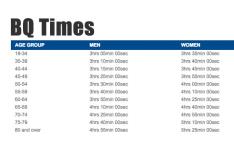Week 3 should be an easy 7- to 8-mile run with no hard effort.
Thursday: Short run of 4 miles (optional non-run workout of a swim or stationary bike with little to no resistance) or off day.
Friday: Complete 9 to 10 miles "as you feel." Finish with 10 x 200m accelerations on the track or on a flat bike path stretch. These 200s should be run at roughly 5K-race pace (this will not feel particularly hard for such a short interval) with a slow 200m jog between each 200.
Saturday: Run easy for as long as you choose.
More: 3 Reasons to Include Recovery Runs in Your Training
Sample Weeks 4, 5, 6, 7
Weeks 4 to 7 within a traditional marathon build-up are often considered the meat of the program. Interval workouts within this period will become more specific as it relates to your target marathon time, and there will be one of your two "marathon-specific" long runs within this month.
More: Marathon Specificity: How to Kick Start Your Training
As some specificity gets added to the marathon build-up, non-workout days need to be utilized for recovery. The late, famous British coach Harry Wilson was fond of saying that rest is not the absence of training but rather part of it. In other words, keep the easy days easy so that your hard days can be executed well.
Sunday Long Run
Weeks 4 and 5: Run 17 to 21 miles controlled with surges over the last 90:00 of the following duration: 1:00, 1:00, 2:00, 1:00, 3:00, 1:00, 7:00, 1:00, 2:00, 1:00 every 7 to 8 minutes. Remember to remain assertive yet controlled. Between each surge simply return back to a comfortable training rhythm. Run the pick-ups only so fast so you can return to your pre-surge tempo easily.
Week 6 should be absent of a true long run (cap at 14 to 15 miles). In addition, there shouldn't be a hard mid-week workout—this is a planned "down" week, effort-wise.
Week 7 is one of your two marathon-specific long runs (see below). Conclude the run with 6 x 100m strides for economy.
- 3
- of
- 5
About the Author

Get ACTIVE on the Go


Couch to 5K®
The best way to get new runners off the couch and across the finish line of their first 5K.
Available for iOS | Android







Discuss This Article